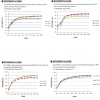This is something im deciding on myself. First, this for a very small space so cost is not an issue. I too am thinking about nearly 2 strips per sq ft, close to 200 diodes per sq ft, with additional red monos. My concern is i would be running strips very,very softly, around 6-8 watts per strip. But when i visualize it in mind i imagine the rig would need to be very , vey close to the tops, maybe 6 to 10inches from top of canopy at peak flower. Which would make use of uvb difficult. I could just go with 1 strip per sq ft, and with that i believe the rig would never need to less than 12” from canopy.
What do u guys with hands on experience with strips think?




